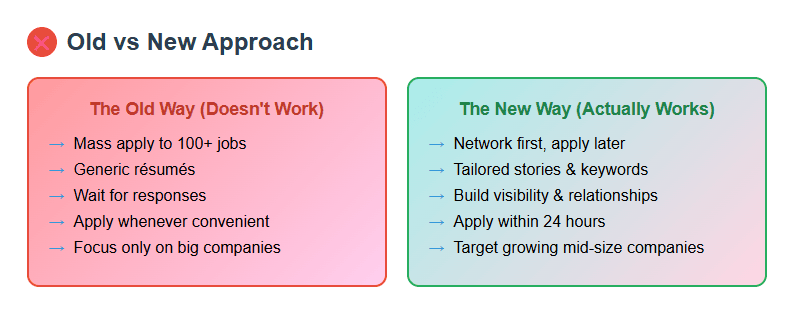Job Hunting Feels Broken, Because It Is
If looking for a job feels harder than ever, you’re not imagining it.
For many people: new grads, mid-career professionals, even seasoned executives, the job search has gone from frustrating to downright demoralizing. Endless applications go unanswered. Positions vanish mid-process. Roles that used to be stepping stones have disappeared completely.
Career coaches aren’t sugarcoating it. Some are calling this market a “dumpster fire.” And while that might sound dramatic, there’s truth behind the heat. Entry-level hiring is down. AI is doing more screening. Layoffs are still rolling through entire industries. And even highly qualified candidates are struggling to get traction.
But here’s the part most people miss: the problem isn’t just the economy. It’s the playbook. What worked a few years ago, firing off dozens of applications on job boards and hoping something sticks, just isn’t cutting it anymore. Getting hired has less to do with volume and more to do with being intentional: knowing what you want, showing up in the right places, and getting in front of the right people.
This article covers how to do exactly that.

Why This Job Market Feels Different… and Worse
Entry-Level Jobs Are Disappearing
In many industries, especially tech, entry-level roles have quietly dried up. The internships, coordinator roles, and “foot-in-the-door” positions that used to kickstart careers? They’re either being absorbed by AI tools, consolidated into hybrid roles, or cut entirely from hiring plans.
This has left a lot of Gen Z workers, especially new graduates, struggling to even get started.
Mid-Career Work Is Shrinking
For professionals in their 30s and 40s, the pressure may look different but feels just as intense. Teams are shrinking. Companies are restructuring. And middle management layers are being gutted in what some are calling “The Great Flattening.”
If you’re not directly revenue-generating or tech-adjacent, you may be seen as expendable, regardless of your performance.
Senior Talent Faces Invisible Hurdles
Even seasoned professionals with strong résumés and leadership experience are getting ghosted. Why? Because many openings are now being filled through internal promotions, referrals, or ultra-specific niche hires, often before the public even sees the posting.
AI résumé filters don’t help either. Highly capable applicants are being screened out by bots before a person ever reviews their materials.
Clarity Isn’t the Problem. Access Is
It’s not that people don’t have skills. It’s that the hiring systems are flooded, opaque, and increasingly dependent on automation and internal pipelines. Qualified candidates are being overlooked not because they aren’t a fit, but because they’re not already “in.”
The good news? Once you stop playing by the old rules, you can start building your own access to DEI jobs. The rest of this guide will show you how.
Job Searching Is the Last Step, Not the First
When you’re unemployed or just ready for a change, instincts probably tell you to ‘fix it fast.’ And it’s natural to want to jump straight into a diversity job board and start smashing apply.
In 2025 sending out cold applications with no plan is the same as tossing pennies in a wishing well. It can feel like a momentum, but it rarely gets you anywhere.
Slow Down and Get Clear First
Before you go chasing that new job, take some time and figure out what you’re actually looking for. Get super specific about the kind of work you want to do, the type of companies you think you’d thrive in, and the value you can bring, that’s relevant right now.
You don’t need every detail dialed up and locked in, but if your goal is just “anything better than this,” hiring managers will catch that vibe. Vague and ambiguous doesn’t sell.
Make Your Story Make Sense
People shouldn’t have to guess what you are good at or what you want to do. If your story isn’t clear, on your résumé or social media profiles, it’s easy to get overlooked… no matter how strong your background is.
Start there. Refine it until it clicks. You want someone who barely knows you to see your background and think, “Oh yeah, I get what they do and I know someone who needs that.”
Let Job Postings Guide You
Instead of applying to everything, treat job descriptions like research material. Pay attention to patterns: what do they keep asking for? What tools, traits, or experience show up again and again?
Use that as your blueprint, not just for how to frame your background, but for who you should be talking to next.

Network First, Apply Later
In the current market, sending out 100 résumés and hoping for a bite is like throwing darts blindfolded. Most job listings get flooded with applications in the first 24 hours. By the time yours lands, someone’s already been referred, or the role’s already half-filled internally.
And with AI now filtering many applications before a recruiter even sees them, you’re not just competing with people, you’re competing with an algorithm.
Talk to People Before You Need a Job
When’s the best time to build those relationships? Honestly, way before you’re feeling desperate. If you have already started your job hunt fear not, it’s never too late to start reaching out.
Skip the boring and generic “Can you help me find a job?” messages. Instead, try out:
- “I’ve been following you and your work for a while now, and I would love to hear how you got into [position].”
- “I’m thinking about shifting into the [industry/job] space and I was just curious, what do you wish you knew starting out.”
- “I saw your company just posted [position]. Do you have a few minutes to talk about what success looks like there?”
People are so much more likely to respond to genuine curiosity than to a résumé attachment out of nowhere.
Use What You Already Have
Start with people you know… Or maybe, at least, have something in common with. Connect with alum networks, maybe your former coworkers, check related professional associations. Even people in your town, or the field your trying to get into, can have an ‘in.’ You don’t need hundreds of contacts. But a few real conversations can unlock opportunities that no job board ever could.
Plus, good news, you can network even if you’re introverted. Fun fact, many introverts actually thrive here because they listen well, follow up thoughtfully, and don’t treat conversations like a transaction.
LinkedIn Isn’t Just for Posting
You don’t have to go viral. You just need to be seen.
Comment on posts from people in your field. Share a short infographic reflecting on something you’re learning. React to news and posts with some of your own insights, and if you do it consistently, people will start to recognize your name. That familiarity makes your DMs land better, and your résumé more likely to get a real look-over when you’re ready to send it.
Build Visibility and Personal Branding
A lot of people hear “build your brand” and immediately think of cringey self-promotion. Building visibility doesn’t mean turning into a content pumping machine or trying to sound like an expert on everything (no one likes a know-it-all).
What it really boils down to is regularly commenting and posting. You want to giving people a sense of what you care about, what you’re good at, and how you think. That’s it.
Start Small and Stay Real
If coming up with posts feels intimidating at first, just start by commenting. Share (with or without your own note) and respond to things people in your field are posting. Press that “celebrate” button to congratulate someone on their new role. Ask a question that goes deeper or add your own thoughts. Every interaction helps build familiarity and in turn, can lead to real conversations.
If you do decide to post, keep it simple. A few ideas:
- Share something you recently learned or unlearned.
- Talk about a challenge you’ve worked through in your career, and how you did it.
- Share a new tool, fresh article, or a personal insight that’s actually helped you lately.
Forget likes or reach. The main goal of social media should just be to stay visible to the people who matter when an position opens up.
Let People Know What You’re About
Your headline and summary shouldn’t just list your title. They should say what kind of problems you solve and what kind of work you’re looking for. More like a personal intro, less like a résumé.
For example:
Helping mission-driven companies grow through smart storytelling & content strategy.
Is way better than:
Marketing Specialist | Project Manager | Copywriter
It gives people a hook. Something they can remember and repeat.
Keywords Still Matter
Even though network connections are your biggest asset, algorithms do still play a part. That means your profile needs to speak the same language recruiters use when they are searching for candidates.
Look at the job descriptions for your desired target jobs. Notice the words that show up over and over. Then make sure those same words are showing up in your skills section, your summary, and your experience bullets.
It isn’t “gaming the system,” you’re simply making it easier for the right people to find you.
Strategic Timing & Edge
Most job seekers apply when it fits their schedule: evenings, weekends, maybe a during a quiet lunch break. But the fact is, early applicants have a serious advantage, especially in a saturated market.
Some jobs get hundreds of submissions within the first 24 hours. Many don’t stay open long enough to be “fair.” People doing the hiring start reviewing the first batch of résumés that comes in. So, if your résumé shows up three days after a job’s posted, the stack is already huge and, yours might never even get seen.
Set Alerts and Move Quickly
Setting up alerts on the platforms you use most can be a game changer: Diversity Employment, LinkedIn, Indeed, or even the company’s career pages. Being notified when a job first gets posted lets you apply to those new openings as soon as they go live.
Move quickly and efficiently. Sending a sloppy application early won’t help. But, a good solid résumé sent within the first few hours? That can absolutely increase your chances of being seen.
Referrals Leapfrog the Line
If you’re lucky enough to know someone at the company you’re thinking of applying to, even loosely, don’t hesitate to reach out. A quick, “Hey, I saw this position and I’m really excited about applying to it. Would you feel comfortable referring me?” can make a huge difference.
You really don’t need a deep relationship. Just need to be clear, respectful and professional. A lot of companies even reward employees for referrals, so don’t look at it as an imposition, it could very well be a mutual benefit.
Don’t Rely on Postings Alone
By the time a job’s posted there is a pretty good chance someone, maybe even internally, already has their eye on it. Not to discourage you, it’s just a valid reminder that visibility and timing go hand-in-hand. The sooner you know what’s available (ideally before it’s public), the better your odds will be.
Pivot Careers Thoughtfully, Not Desperately
When jobs feel scarce, it’s tempting to pivot into anything that looks stable. Healthcare. Cybersecurity. Project management. Whatever’s trending. But jumping into a whole new field without a plan usually leads to more frustration, not less.
The goal isn’t just to get out of where you are. It’s to move toward something that fits. Otherwise, you risk trading one dead end for another.
Don’t Just Rebrand
Before you rewrite your résumé or dive into in a bootcamp, take a step back. What are professionals in your desired field actually doing every day? Do they love their work? What’s something that’s challenging? What skills are absolutely required?
Talk to people who already work in the position you want and ask them about their career path. A great question is to ask what they’d do differently when they first started out. It can help you decide if a job really is a good fit for you, and this can give you verbiage and language to sound good when you talk about your transition.
Look for Overlaps
Most successful pivots don’t come from starting over, they simply reframe what you’ve already done.
Say you worked in customer support but want to move into UX research. Maybe you’ve spent years listening to user frustrations, explaining systems in plain language, and spotting patterns. That’s not wasted time. That’s relevant experience. You just have to articulate it well.
Test the Waters
If you’re not totally sure about diving into a new path, look for a low-risk way to try it out:
- Volunteer with an organization that could use your skills.
- Take on a small freelance project.
- Shadow someone in the role.
- Join a community or online cohort related to that space.
You don’t need to change your whole identity overnight. Sometimes a pivot works best in phases.
Don’t Pivot For “Safe”
Every industry has risks. Even ‘stable’ fields like tech and education have been seeing layoffs, restructuring, and worst of all, burnout. Don’t just chase security, move toward something that feels right with how you want to work and live.
The most sustainable pivots come from curiosity, not fear.
Follow the Energy, Not Headlines
Some sectors are quietly, yet steadily, growing. And there’s a growing need for smart, adaptable people.
Healthcare, logistics, education, renewable energy, clean manufacturing, trades, hospitality, and skilled caregiving are all growing in their own different ways. They may not be as flashy as tech or media, but they are hiring, and they usually come with a more bearable pace and more clear career ladders.
Stability Doesn’t Mean Stay in Your Lane
A good example would be an MBA grad who leaves the ‘corporate grind’ to re-train as a CNA (certified nursing assistant). The move may look like a step backward on paper, but in reality, it offers stability, impact, and much more room to grow. Same thing goes with professionals who move from marketing to nonprofit operations, or from sales to vocational training. These kinds of pivots are becoming more common, and more widely accepted.
Your next job doesn’t have to look like your last one. Whatever it is should move you forward in a way that works for you.
The Hidden Goldmine
Everyone loves the idea of working at a household-name company. But while Big Tech and Fortune 500s are trimming headcounts, mid-sized and growth-stage companies are generally more flexible, and more willing to take a chance on someone with potential.
They may not have the same prestige, but they tend to move faster, hire with less red tape, and give employees more responsibilities (which just means more chances to grow). Don’t sleep on them.
Look Beyond Traditional Job Boards
Most growing companies don’t only use big-name job boards. They use niche platforms (like the one you’re on now!), newsletters, social communities, or even Instagram and TikTok to share new openings and opportunities. Follow the ones you’re interested in. Stay on their radar. Show up before you apply. And when a position does open up, you’ll be ready and have a better chance to get noticed. Anything to be more than just another résumé in the pile, right?
Mind Your Emotional Well-Being
Let’s be real… job hunting right now is brutal. Even the most qualified people are getting ghosted, rejected, or ignored completely. That stuff messes with your head and can make you question your worth, your skills, or even your career choices.
But this isn’t just about you. It’s about the system. The hiring process is broken in a lot of places, and the economy has made it even harder to break through.
Rejection Isn’t a Reflection of Your Value
You might be amazing and still not get the job. Maybe someone had an inside connection. The company could have changed course mid-hiring. Or maybe they already had a finalist and just had to “post it publicly” for optics.
That doesn’t make you less talented. It just means you weren’t their pick this time. That’s it. No story about your self-worth needed.
Don’t Let the Process Isolate You
The longer you search, the easier it is to pull away. To stop reaching out. To stop asking for help. But that isolation can make everything feel heavier.
Stay connected to friends, to mentors, and to people who “get it.” Even a short quick chat can remind you that you’re not alone.
If you can, find a “job search buddy.” Someone else going through it who can check in, swap tips, and celebrate the small wins with. A little support system goes a long way.
Momentum Matters More Than Motivation
There will be days when you don’t want to even think about writing another cover letter or sending another email. And that’s totally normal. The main thing is that you don’t stop moving.
Do one thing a day, just one. That will get you closer to a conversation, an opportunity, or even just more clarity. You just have to keep going.
Lessons from the Great Recession
If you were job hunting during the 2008 financial crisis, the vibe now might feel familiar: hiring freezes, ghosted applications, endless “entry-level” roles asking for five years of experience. But for Gen Z, this is brand new territory—and that shock is real.
Millennials were once dubbed the “unluckiest generation” for entering the workforce during an economic collapse. Now they’re looking at Gen Z with a mix of empathy and déjà vu.
And weirdly? That’s a good thing. Because the strategies that helped Millennials survive, and eventually thrive, do still work.
Persistence Pays Off (Even When It’s Exhausting)
Back in 2008-2012, many job seekers had to apply to dozens or even hundreds of roles before landing something. That wasn’t a reflection of their talent, it was the market. But the ones who kept showing up, adapting, and asking for help? They found a way through.
Today, it’s the same. If you’re still applying, still networking, still learning, you’re doing it right. It doesn’t always feel productive but staying in motion builds momentum.
Networks Were the Game-Changer Then, Too
One of the biggest regrets Millennials voiced post-recession was not leaning on their networks sooner. Many assumed that applying through formal channels was the “right” way to get a job.
But most people who landed on their feet didn’t do it alone. They asked friends. Reached out to loose connections. Made awkward coffee requests. Got scrappy. And it worked.
Don’t wait to “earn” the right to ask for help. Your connections want to help, you just have to make it easy for them to know how.
Flexibility Opens Doors
In the wake of 2008, a lot of people took jobs outside their original plan. Some switched industries entirely. Others took on freelance, part-time, or contract work just to get in the door.
What many found was that these detours turned into long-term opportunities. They built new skills, made connections, and sometimes ended up in careers they never would’ve considered otherwise.
If you’re staring down a path you didn’t expect to be on, that doesn’t mean you’re lost. It might be the start of something better.
What to Do Now: A Checklist
Feeling stuck is normal, but staying stuck doesn’t have to be. If you’re not sure where to focus your energy next, start here. This isn’t some magic formula, but it is a proven sequence that’s helping job seekers get traction in today’s chaotic market.
1. Clarify Your Target Roles and Career Story
Don’t skip this step. Before you apply to anything, get clear on:
- What jobs you’re actually going for
- What problems you solve
- What strengths you bring to the table
Use real job descriptions to shape your language. If your LinkedIn or résumé feels vague, you’re not ready to hit “submit” yet.
2. Build a Skills-Optimized LinkedIn Profile
Your profile isn’t just a résumé copy-paste. Make sure:
- Your headline says what you actually do (not just your title)
- Your “About” section tells a story, not just a list of skills
- You’re using keywords from job postings in your field
This helps both people and algorithms find you faster.
3. Research Your Network and Message Thoughtfully
Don’t spam your contacts. Connect with purpose:
- Look for people in your target field or company
- Reach out with specific, low-lift asks (“Could I get 15 min to hear how you got into X?”)
- Offer value where you can, even if it’s just curiosity and good questions
People help people who are clear, personal, and respectful of time.
4. Share or Comment to Build Visibility
You don’t need to go viral. You just need to show up:
- Leave thoughtful comments on relevant posts
- Share content with a quick take or reflection
- Respond to people in your space with curiosity
Even a few consistent touches a week puts your name in circulation.
5. Apply Early and Leverage Referrals
Speed matters. So does connection.
- Set alerts to catch new jobs fast
- Apply within the first 24-48 hours whenever possible
- Use your network to get referred whenever you can
Being one of the first and having an internal advocate doubles your odds.
6. Stay Open to Adjacent Roles in Growing Sectors
Your dream job might be a few steps away.
- Explore roles in industries that are hiring (healthcare, logistics, trades, clean energy, etc.)
- Think about how your skills transfer, not just your job title
- Be willing to explore paths you haven’t considered (yet)
Stability sometimes starts where prestige ends.
7. Take Breaks and Protect Your Perspective
Job searching isn’t just work, it’s emotional labor.
- Set limits on your screen time
- Take intentional pauses when you hit burnout
- Celebrate progress (even when there’s no offer yet)
Reminder: This process isn’t just about finding a job. It’s about building a life, and you deserve one that fits.

The 2025 job market isn’t just tough, it’s different. What used to work doesn’t anymore. Mass applications, generic résumés, and passive waiting aren’t getting people hired.
But that doesn’t mean you’re powerless. Today’s market rewards people who lead with clarity, who network with curiosity, who show up as real human beings, not just polished bullet points on a page. The people getting traction right now aren’t always the most experienced, they’re the most intentional.
You don’t have to have it all figured out. You just have to keep showing up with purpose, resilience, and with the knowledge that being you is still your greatest competitive edge. So build your strategy. Know your story. Use your network. Say what you want out loud. And don’t be afraid to ask for help.




